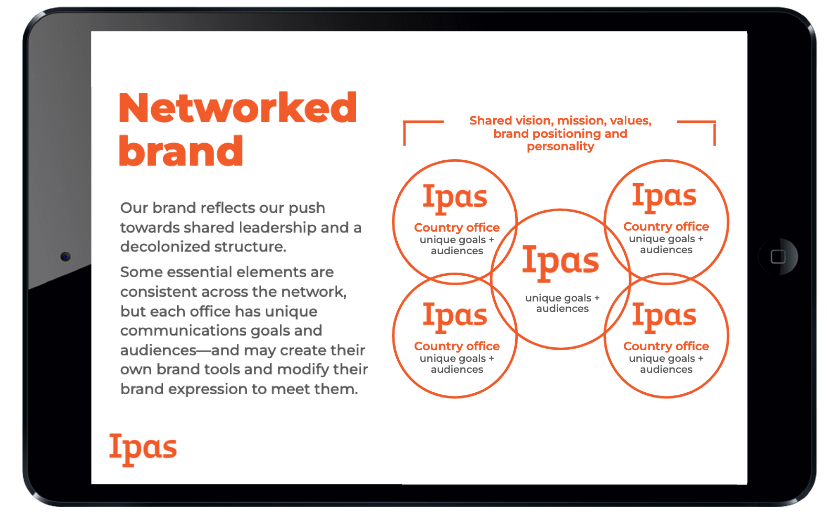Not your typical rebrand: Designing a democratic branding process
In The Brand IDEA by Julia Shepard Stenzel and Nathalie Laidler-Kylander, brand democracy is defined as “the extent to which an organization engages its board, staff, members, participants, volunteers, supporters, and other stakeholders in both defining and communicating the brand identity.” Brand democracy is a commitment to crafting a brand that works for everyone, and as a practice, ensures all relevant stakeholders feel represented. It’s about sharing power and making communications authentically rooted in the communities we serve, the staff that power our work, and the funders that support it. Sounds great–at least in theory!
As we push ourselves and our clients to adopt more equitable practices, we’re excited about this idea of “brand democracy”. Old ideas of having a single brand “champion” or spokesperson are outdated, problematic, and misaligned with common nonprofit goals of inclusion and movement-building. It’s simply not true that a brand must be tightly regulated and managed to be effective; the strongest brands today are the ones that make all staff and supporters feel inspired and equipped to speak with an organization’s powerful brand voice. But one size never fits all, so what would that practice look like for an organization that has offices and staff all over the globe?
Well, that was the exact question Ipas was grappling with when they tapped Big Duck to lead them in their (and our!) first-ever global democratic brand rollout. The almost-50-year-old nonprofit committed to global reproductive justice came to us with the hopes of creating a brand that worked for everyone: leadership, staff, board, clients, and the various communities they serve across five different continents. As a result, we co-created a bright, dynamic, powerful brand that emphasizes multiculturalism, community, and solidarity–all codified in an interactive digital brand guide, complete with worksheets, tutorials, and downloadable templates and assets. As the strategist on the project, I learned so much from working with this organization, and I hope you will too in this conversation with Ipas’ director of communications, Jennifer Holloway.
Marissa Lea Gaston: How about we start with a little insight as to where the organization was strategically when you endeavored to do this. What compelled Ipas to rebrand, and how did you decide you wanted to explore a more democratic, collective approach?
Jennifer Holloway: Sure; the “why” for us was a bit of a confluence of many things: We recognized a couple of years ago that we needed to revise our strategies and structure to sharpen our human rights lens and our commitment to access, equity, and shifting power. Various external factors–like climate, pandemics, political shifts, and rising movements, both opposition and reproductive rights–prompted these changes. We also found ourselves in the midst of a racial reckoning so we leaned into our collective belief in justice, and how abortion access is one component of reproductive justice, which is so connected to other movements, like climate justice, gender justice, and more.
Shifting power to the people closest to our work is important; this work informed our brand refresh and drove our decision to focus on brand democracy.
Marissa Lea Gaston: You’re an organization with 17 country offices across the globe: how were staff engaged in developing the brand strategy, giving feedback to the new type, logo, colors, messaging – not to mention translating all of that – along the way?
Jennifer Holloway: We’re constantly learning how to be more inclusive, across geographies, time zones, languages, etc. We started back in 2020, engaging staff in brand awareness through all-staff webinars. We talked about what a nonprofit brand is, what it means to be a brand ambassador, and why it’s important. When we began our work with you at Big Duck, we knew we had to create multiple avenues for staff input and feedback–and transparency. We surveyed all staff on important brand goals and audiences, and we formed several representative groups during the process, drawing in staff from different contexts within Ipas, to help develop our brand strategy, to share thoughts on the visual identity and messaging, and to help us translate and then share the refreshed brand. We continue to collaborate across our country teams, now with brand champions who are part of a Communications community of practice.

Marissa Lea Gaston: Ipas’ digital brand guide was made to be adapted by country offices, so we collaborated on video tutorials, prompts, and worksheets to help them do just that. How did you decide which components of your brand strategy should be consistent across the board, and which could be adapted by country offices?
Jennifer Holloway: We started with the understanding that each country’s office works in varying contexts. We’re working on expanding access to abortion and contraception to contribute to reproductive justice for all–our mission, vision, and values were constants. Our bold logo and the orange in it are constant. These things unify us across our evolving network. But country teams can decide best which personality “traits” they live into–based on their key audiences, and the context where they work, for example. We knew we wanted to create a supportive, flexible base from which all teams would be unified, could collaborate and share ideas and innovation, and could best represent the Ipas brand.
Marissa Lea Gaston: You just hired a network brand ambassador in Kenya. Congrats! What will this new role entail, and how does it support brand democracy?
Jennifer Holloway: Yes! We’re excited. She is one of several who will work for the Ipas network in positions that had traditionally been housed in the US. Though you’re right, this is a new role, and one that needs to be closer to our country teams, and familiar with their contexts. The network brand ambassador will be a direct liaison from Communications to those teams and vice versa, sharing communications skills, and providing support to teams on how to best showcase and represent the Ipas brand with specific audiences across a variety of mediums. She will really listen and engage with teams to determine what they need, what works for them, and how to meet their goals, and she’ll be able to dig a little deeper into their successes and impact so that we can share with our global audiences.
Marissa Lea Gaston: What were the biggest challenges of this rebranding process? Were there any surprises along the way?
Jennifer Holloway: I think one challenge we experienced with this brand refresh was how to step outside our “old way of doing things.” As I mentioned earlier, we’re doing a lot of work to evolve Ipas and shift power, so finding ways to be inclusive across geographies, contexts, languages, and internal structures is important–so we sought input and feedback, and offered regular updates on the brand refresh to all staff. But there are always lessons to learn and ways we could improve our collaboration, so we are engaging in that learning now. Brand democracy requires a certain amount of “letting go” and fresh thinking about what is unifying a global nonprofit brand. It’s exciting and challenging all at once!
Marissa Lea Gaston: Finally, where do you see the global Ipas brand in the future, perhaps 5-10 years from now?
Jennifer Holloway: I believe that the work we’re doing now will mean that Ipas is widely recognized as a trusted, equitable, and effective global network that truly delivers on our mission–to ensure reproductive freedom and autonomy for all, no matter where they live or who they are. In 10 years, we hope that, along with diverse and intersectional partners, we have successfully worked to globalize–and to realize–reproductive justice.







